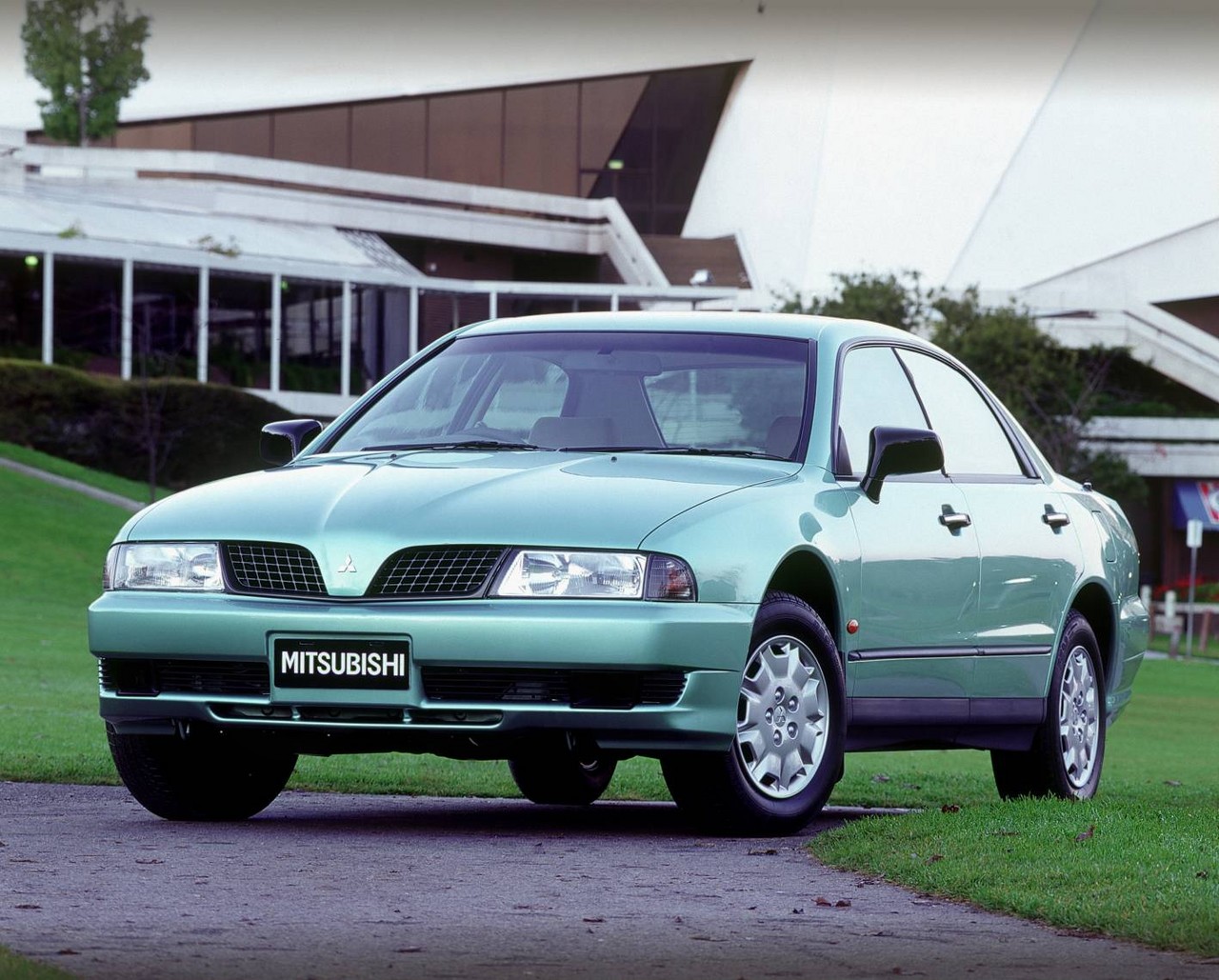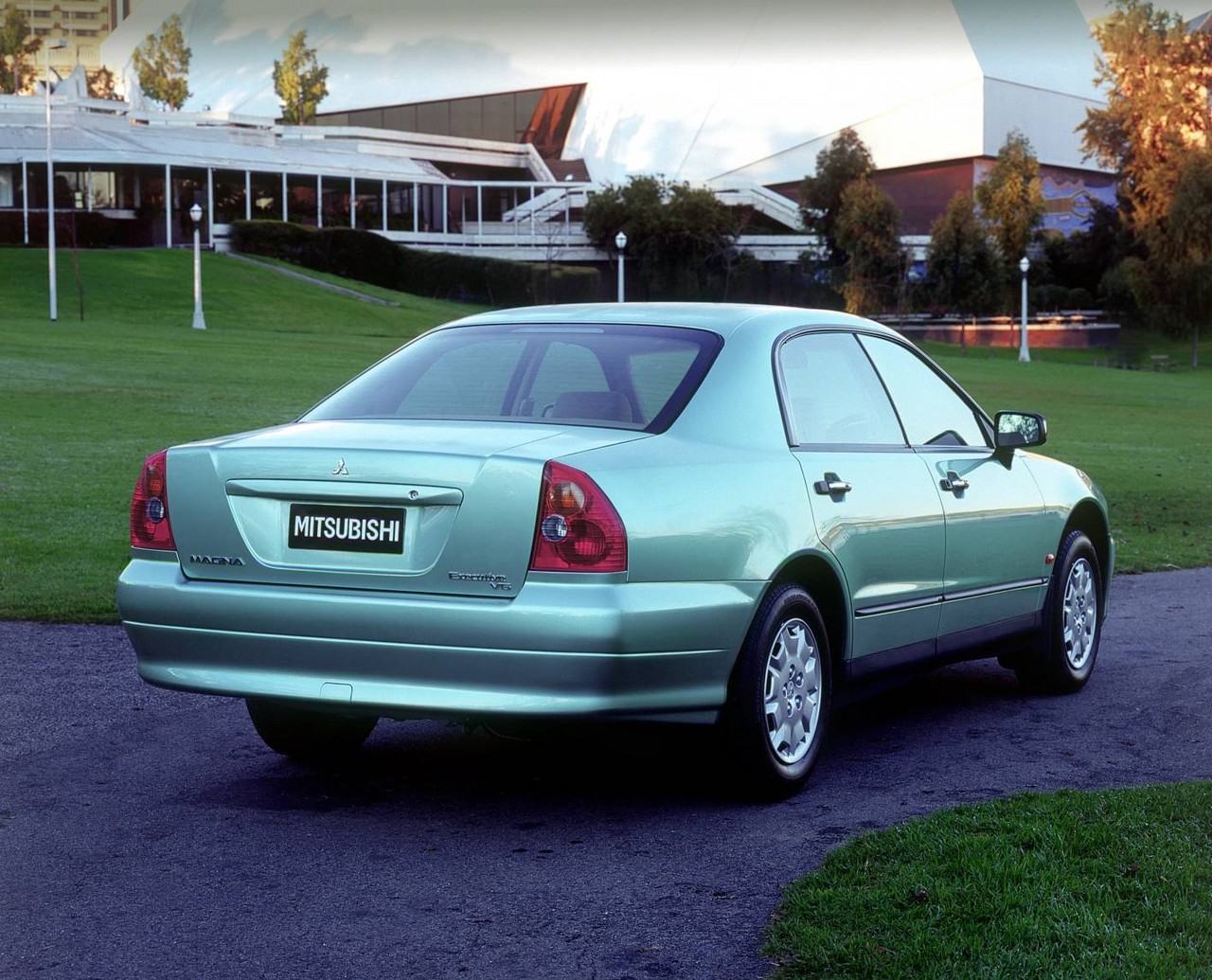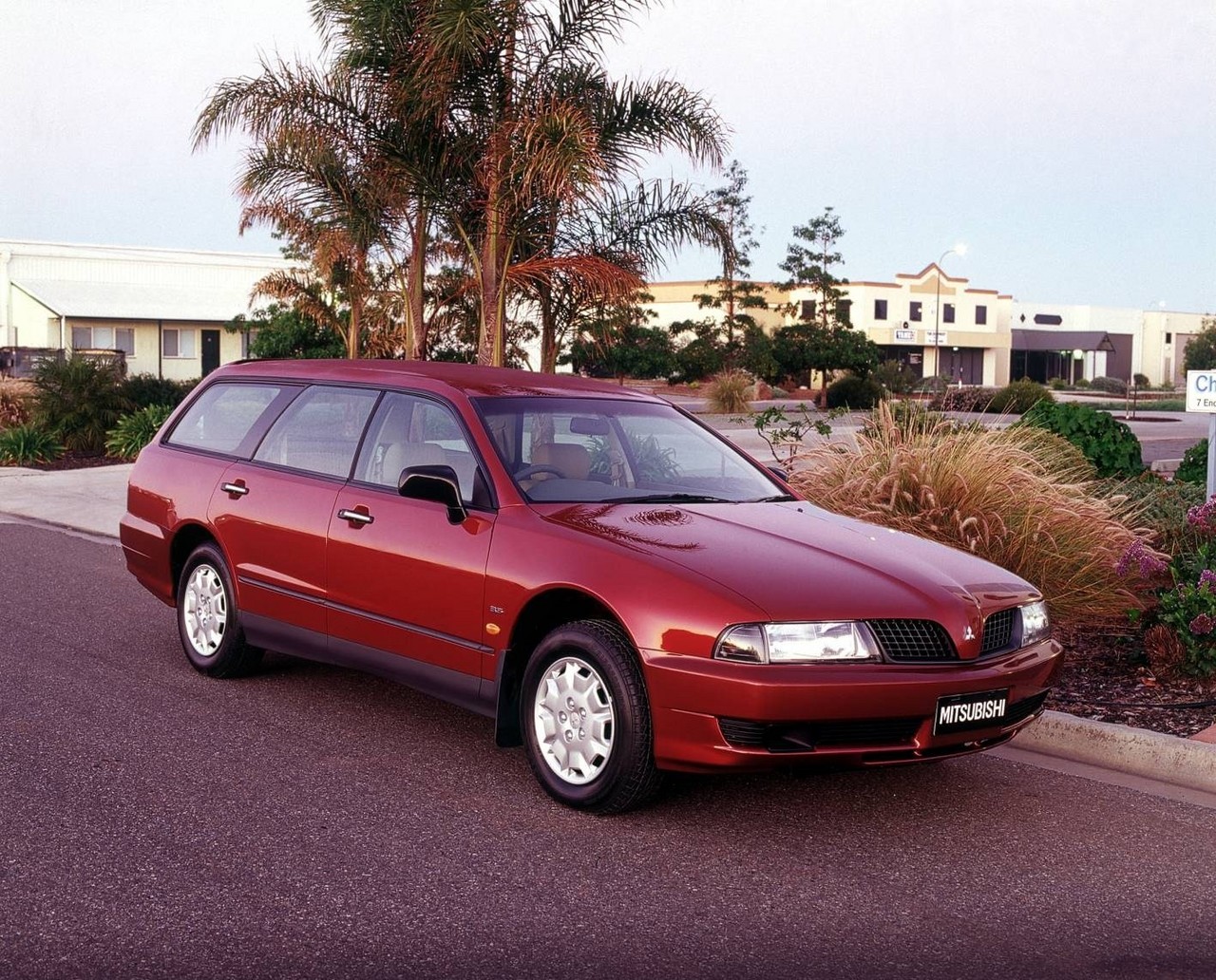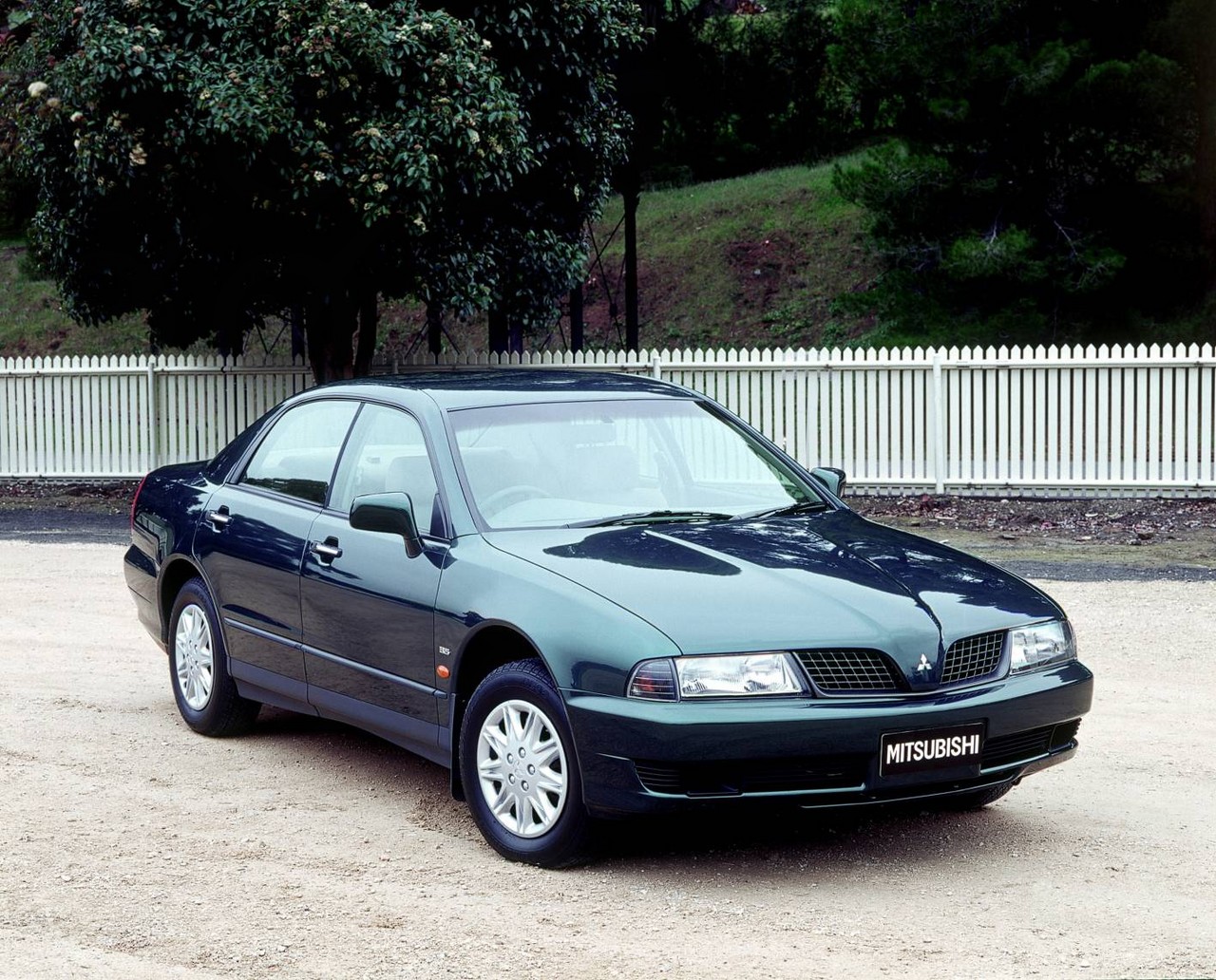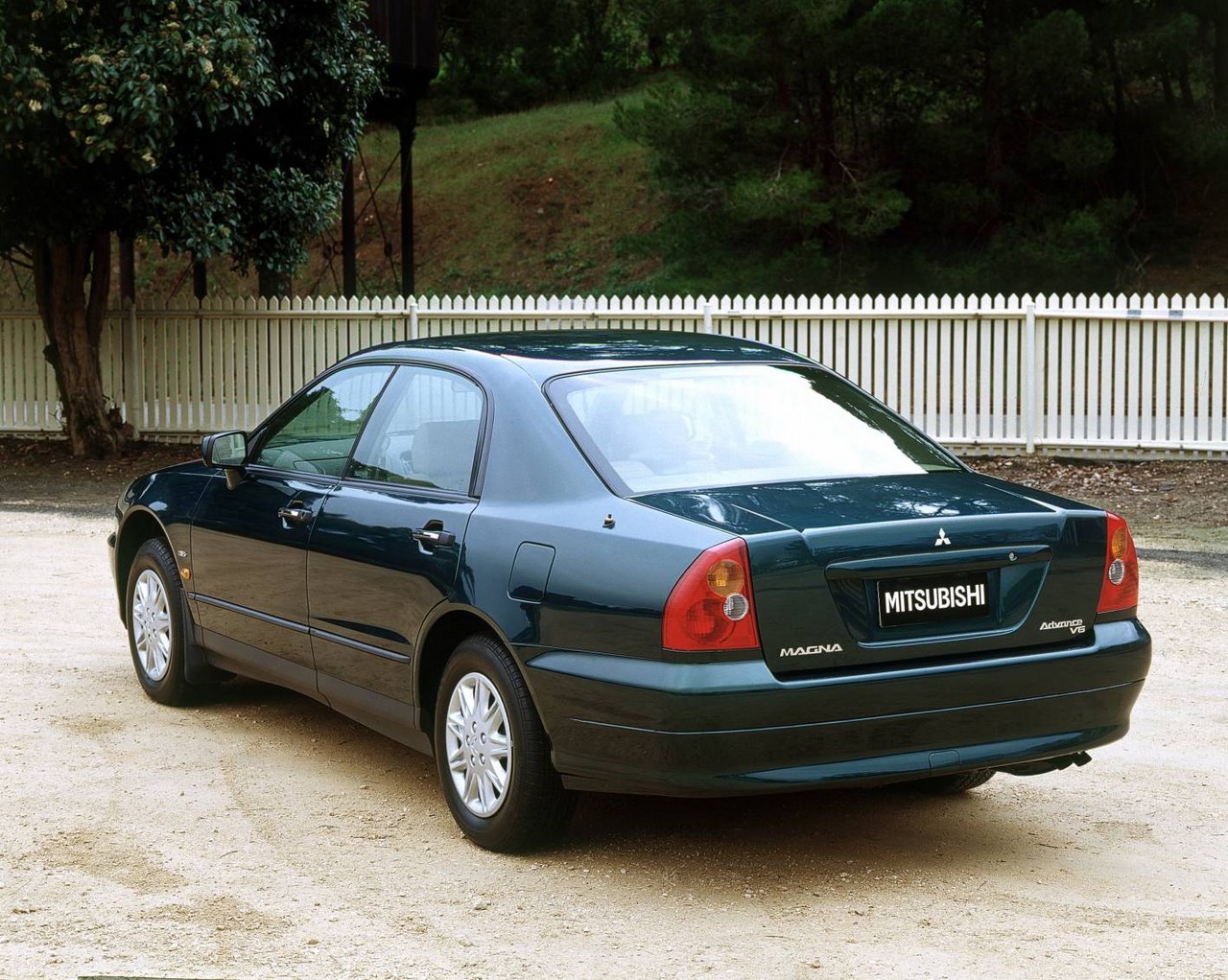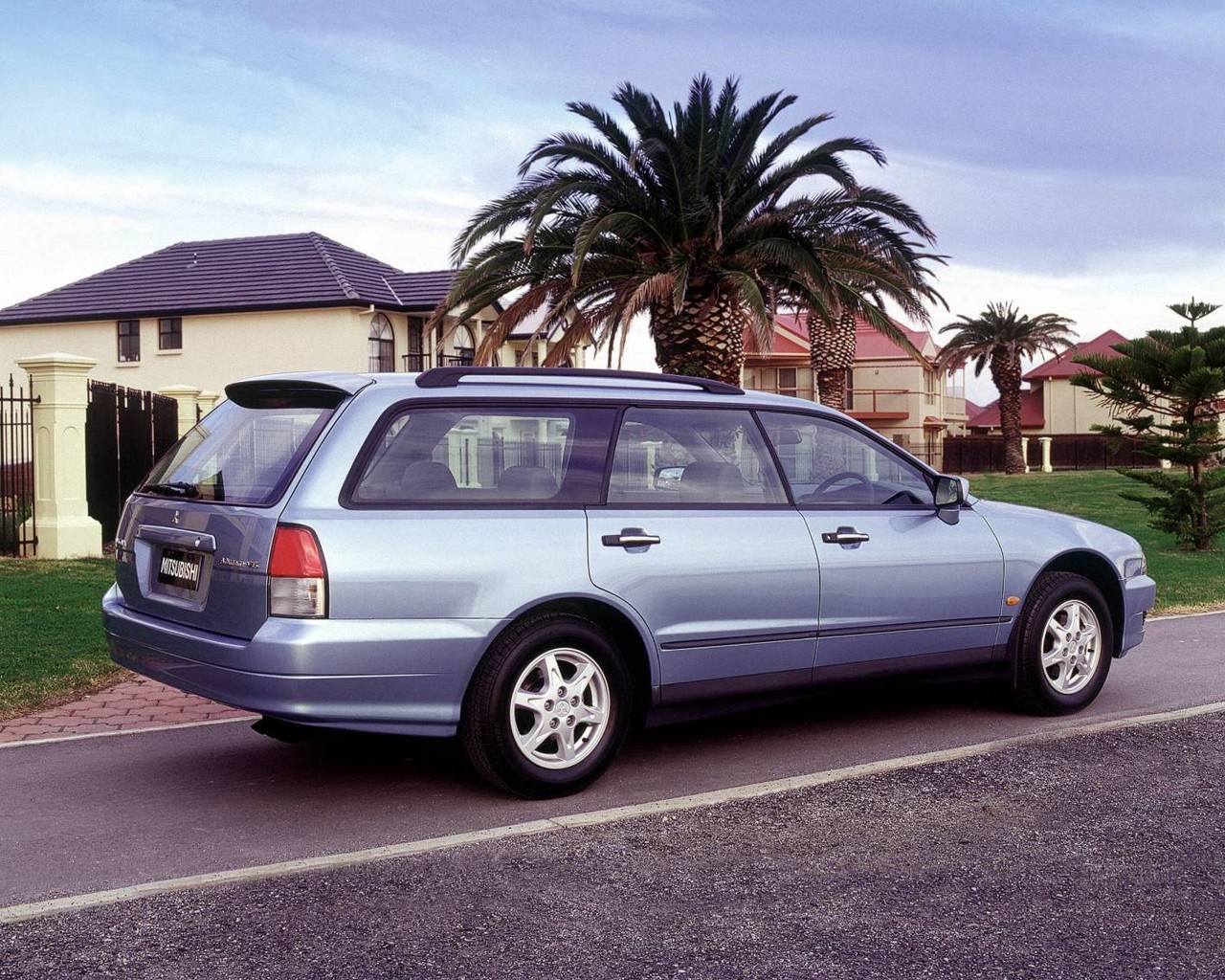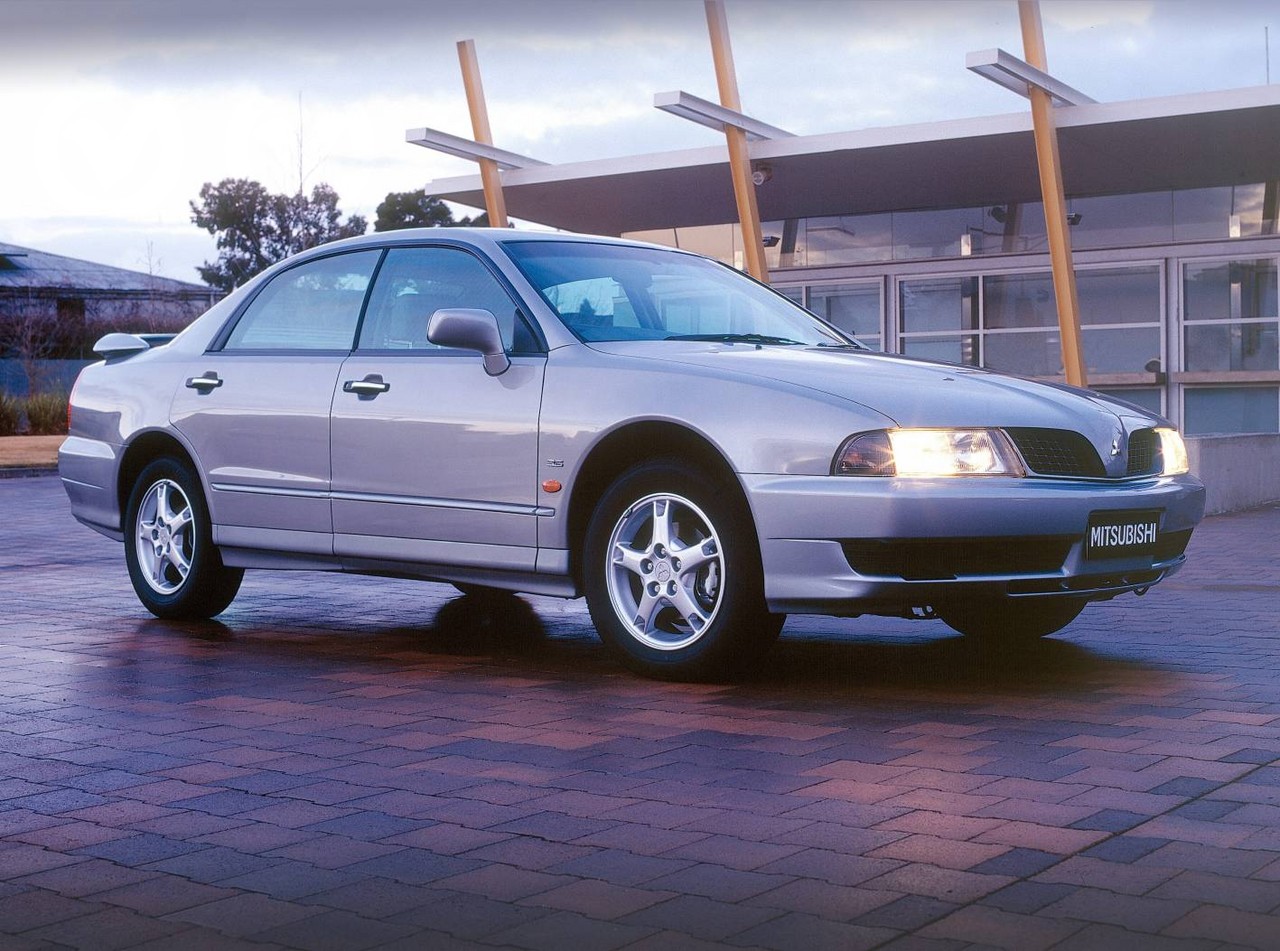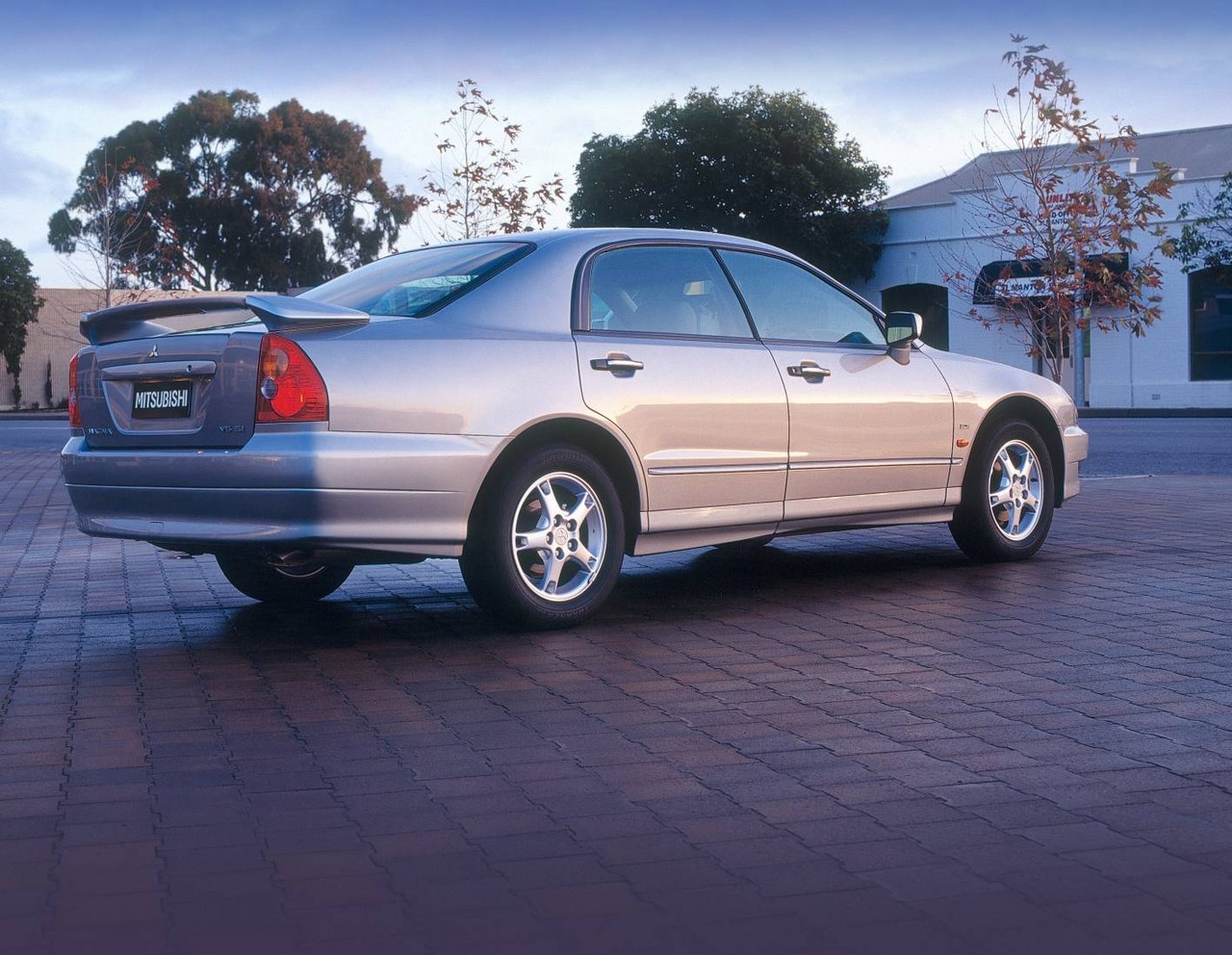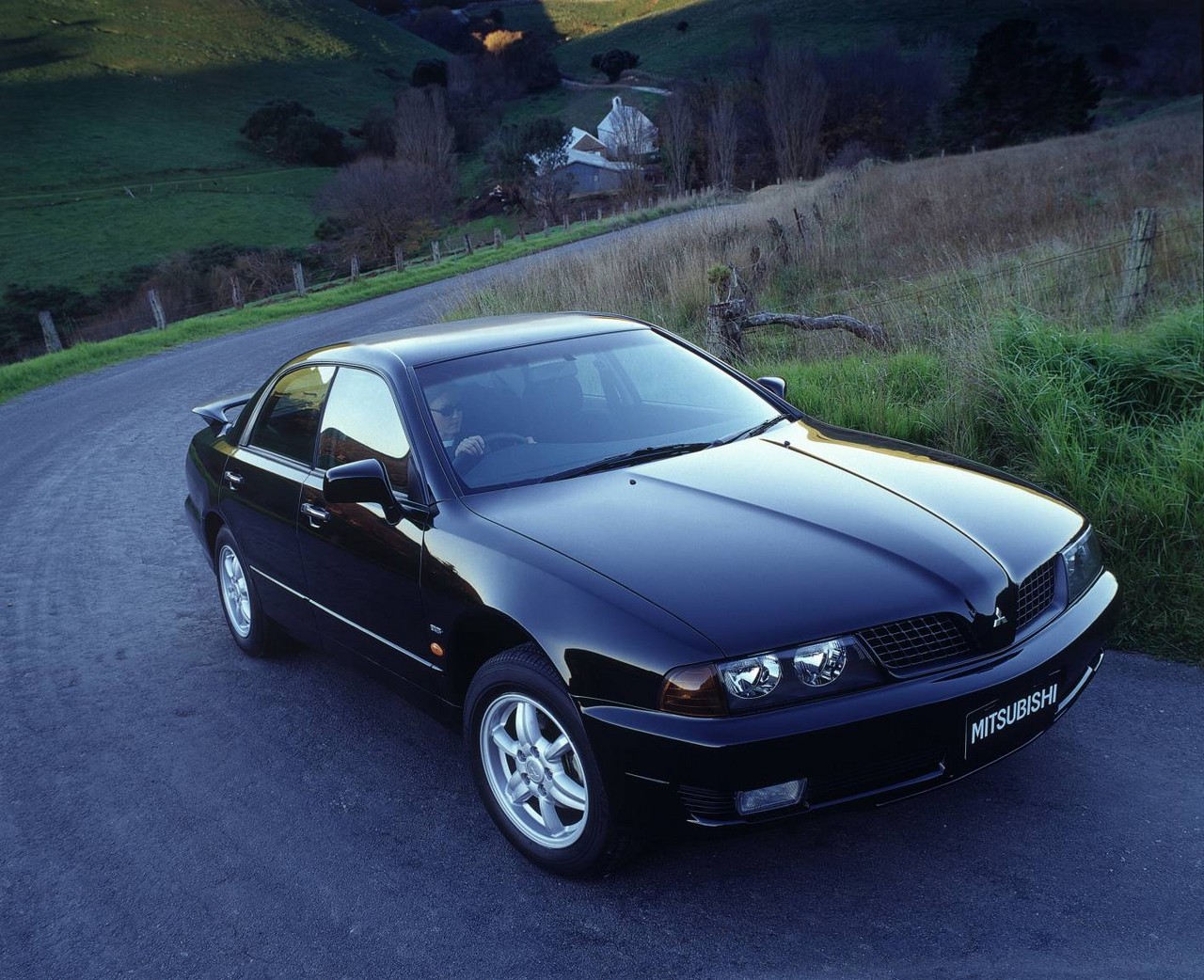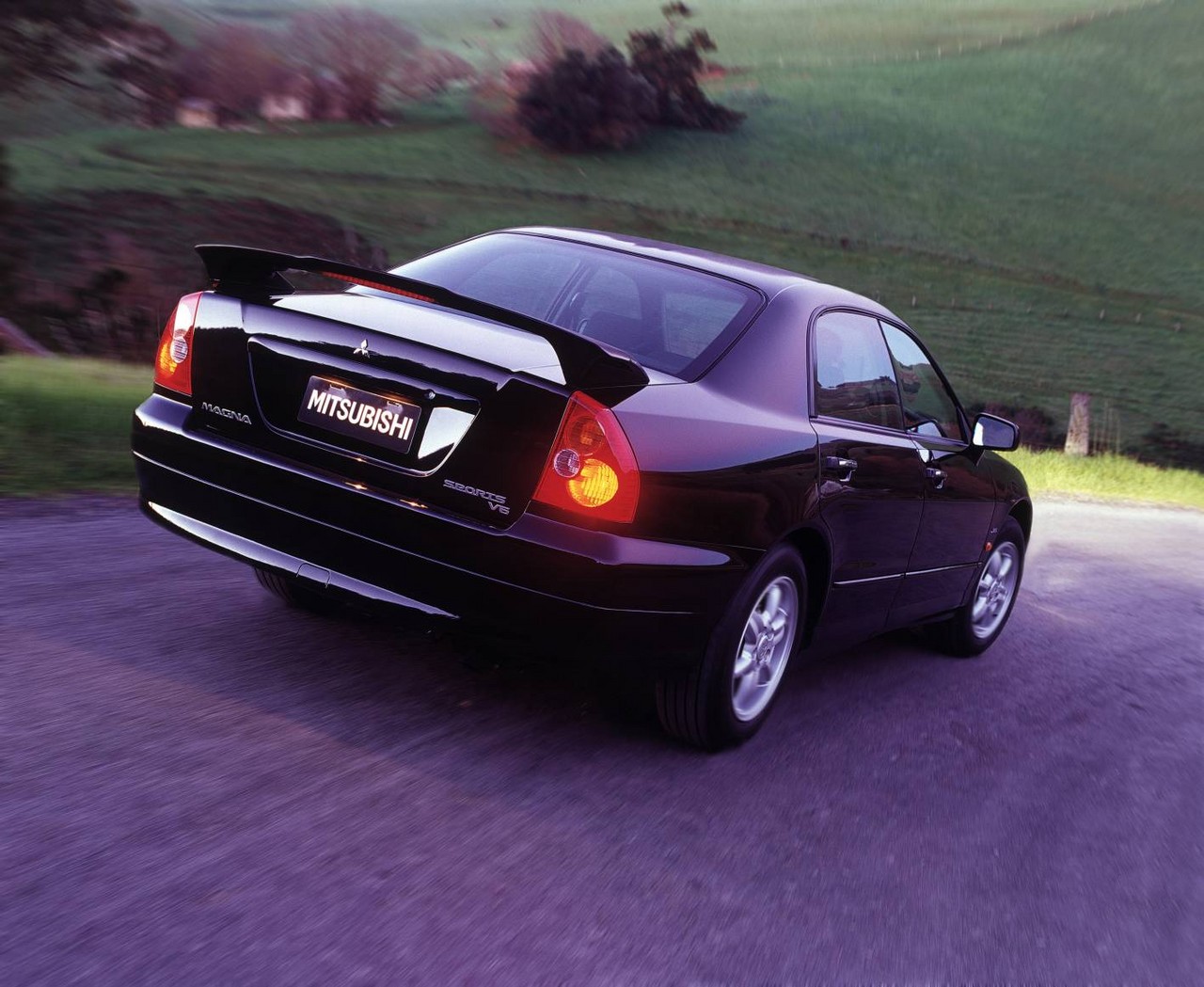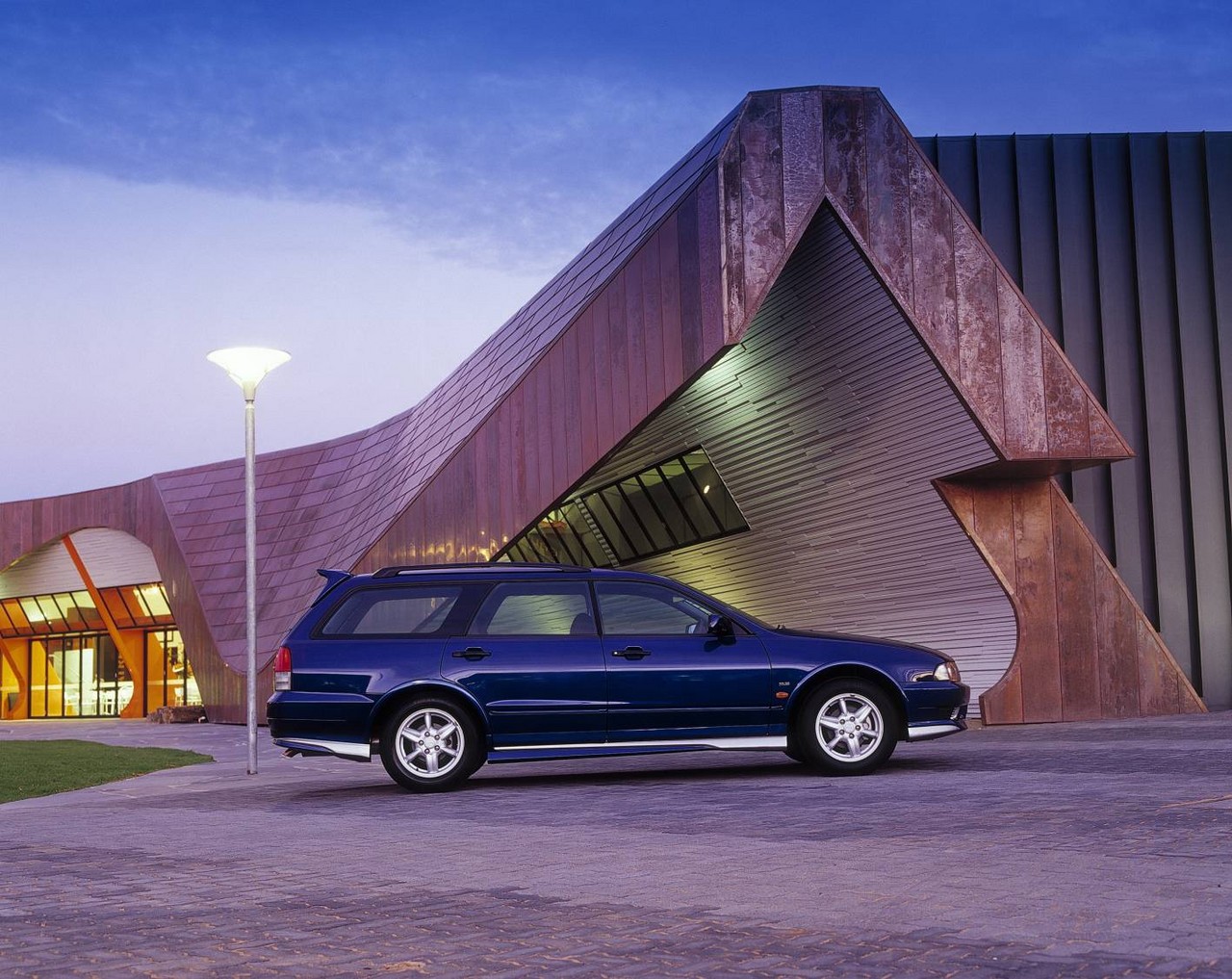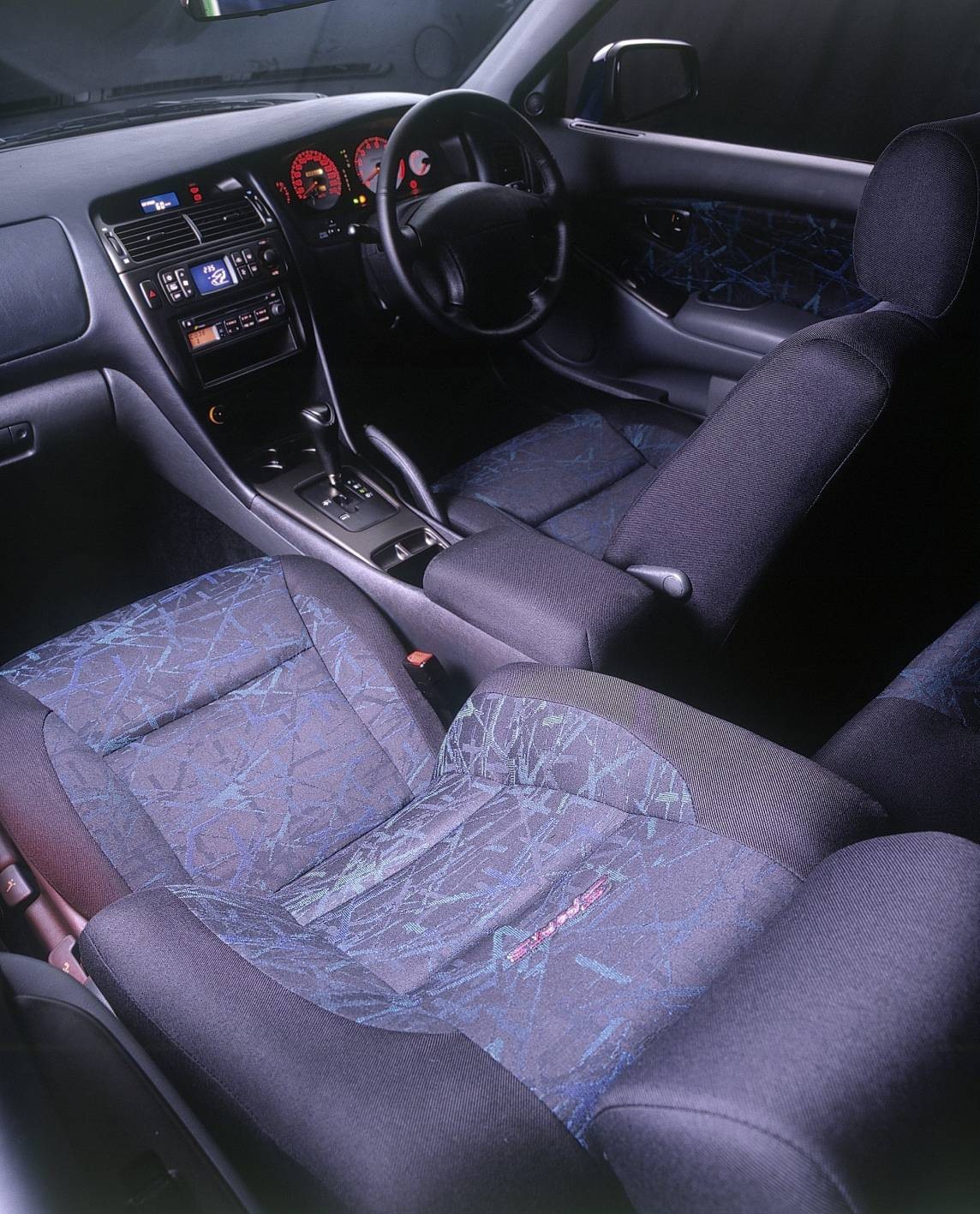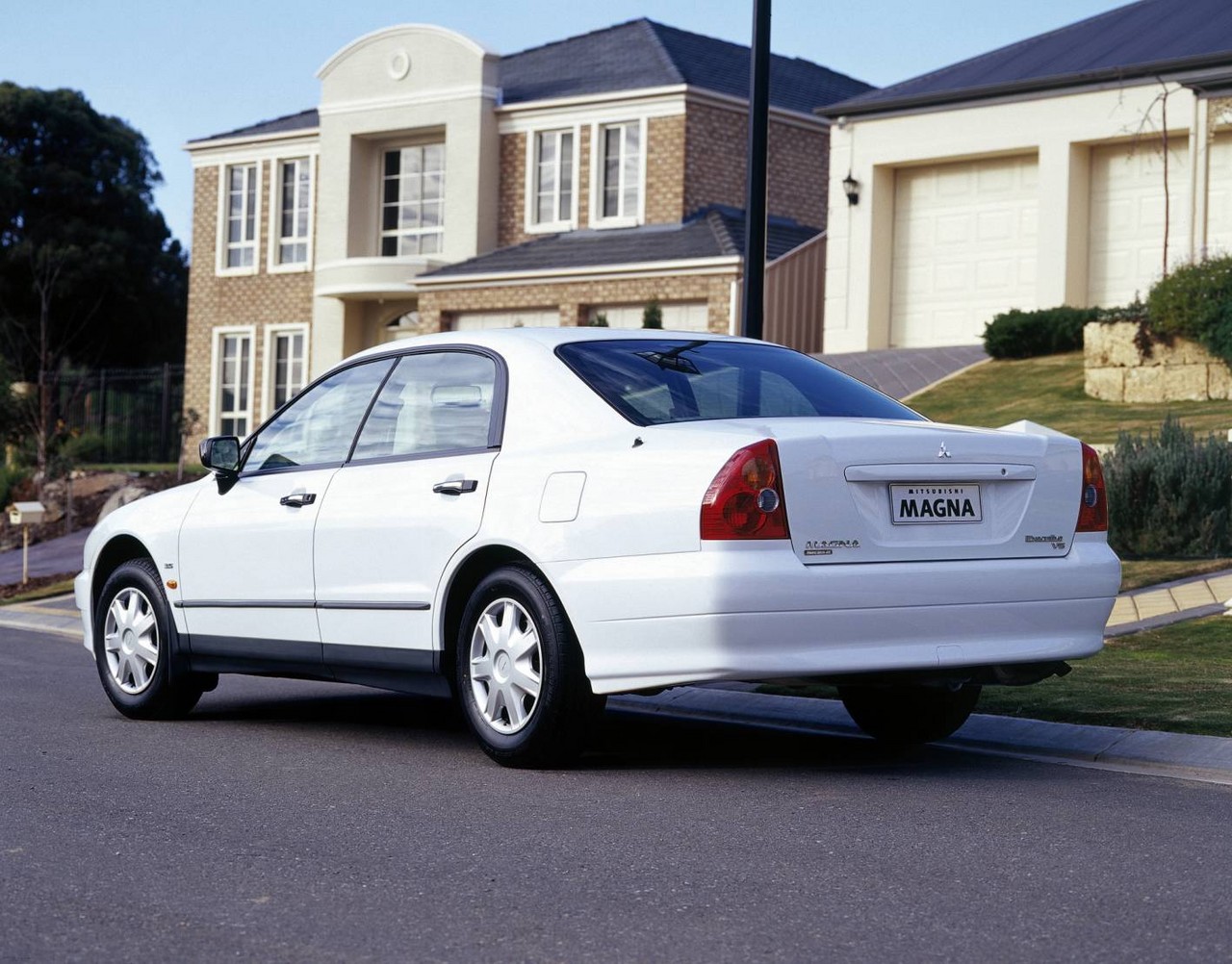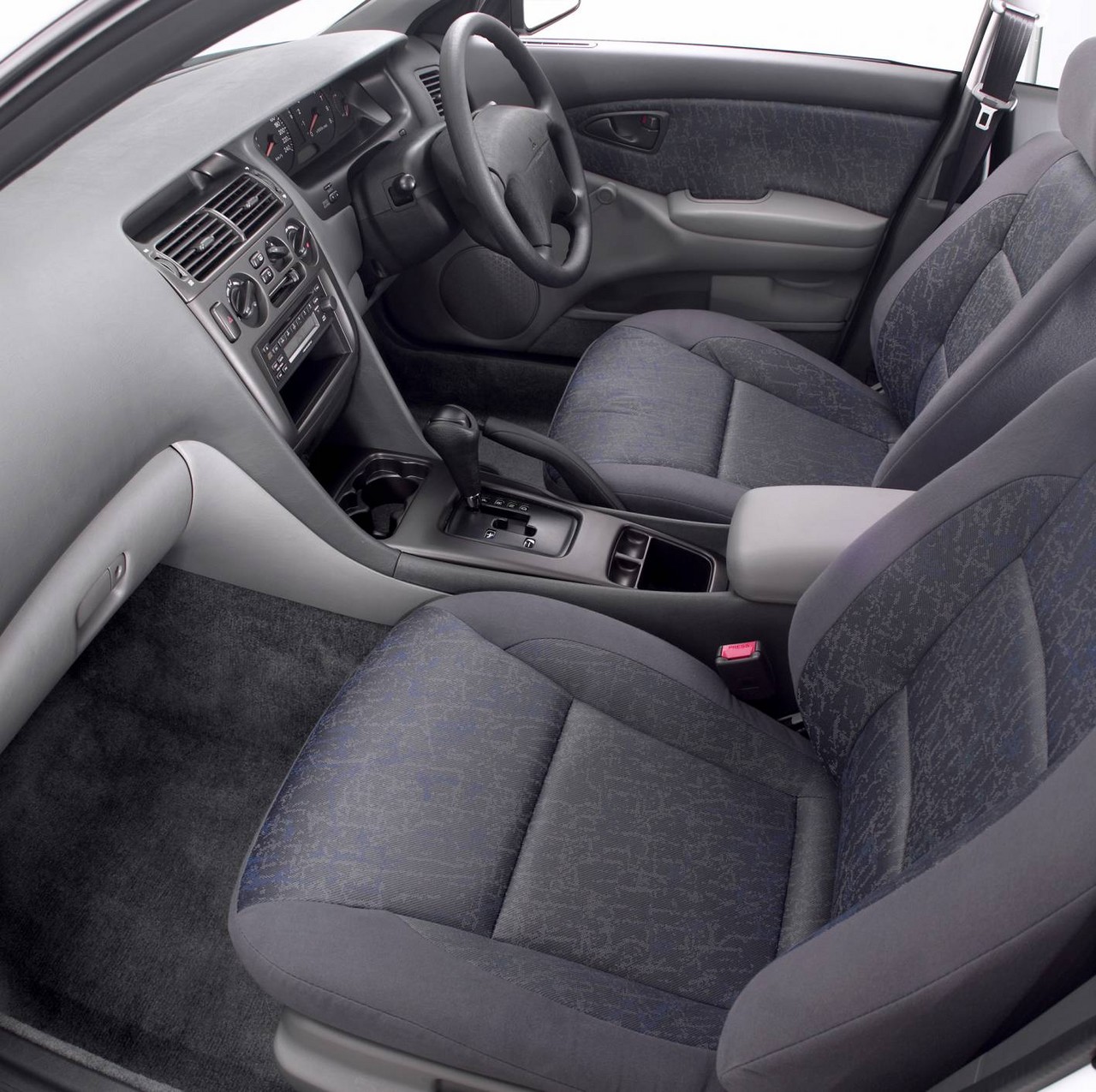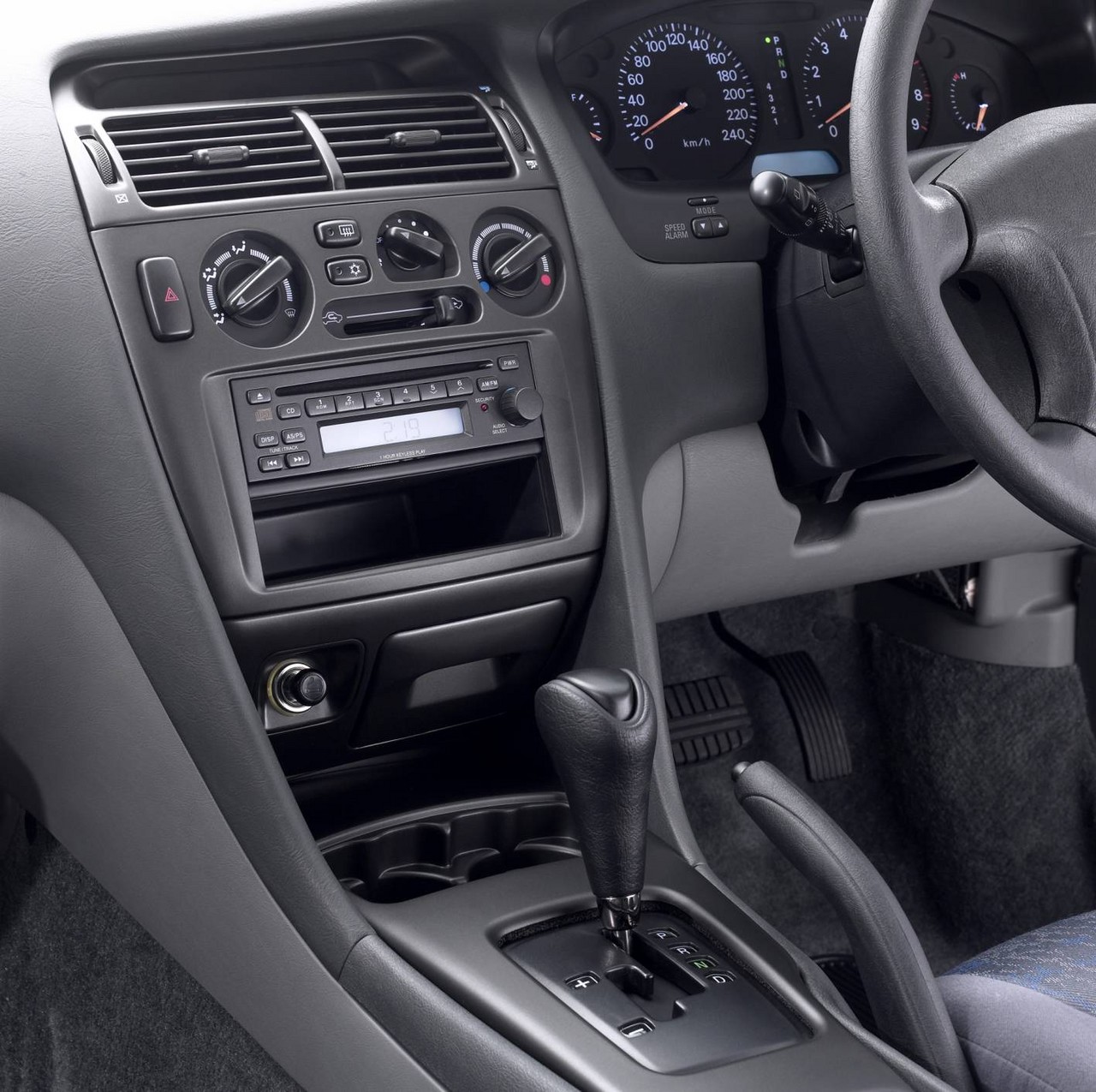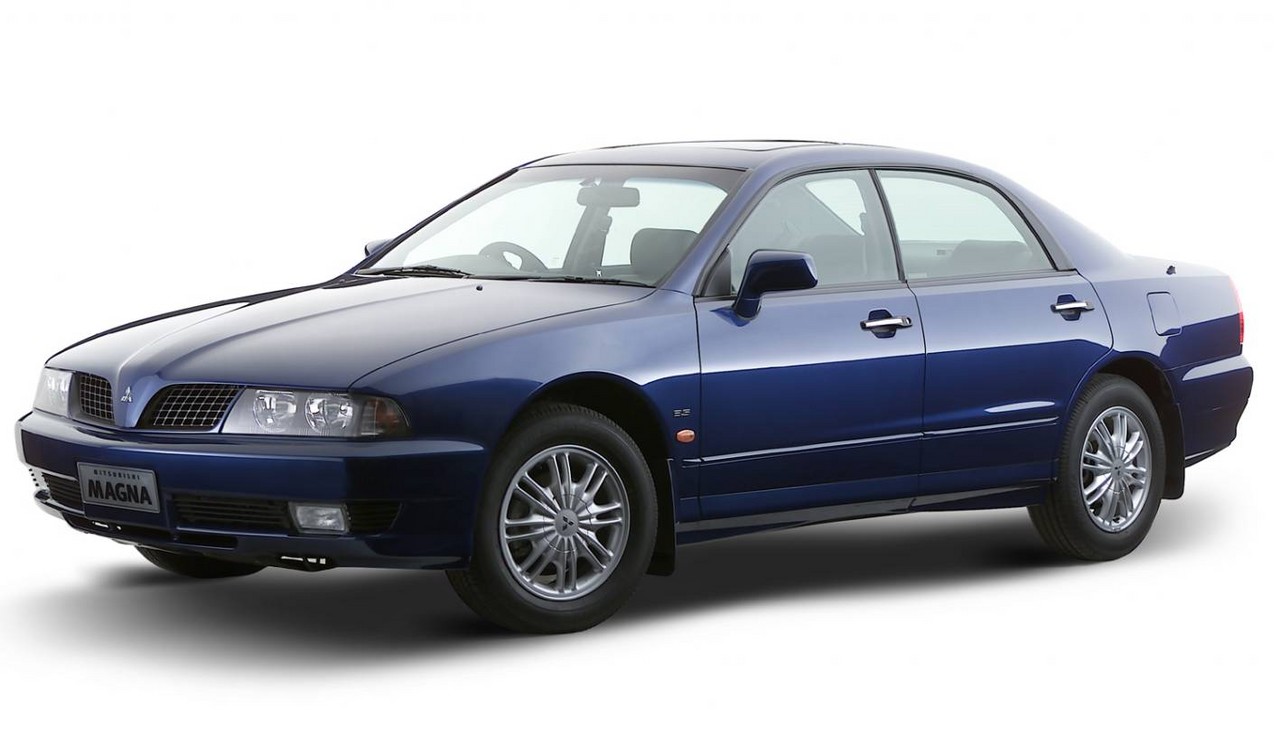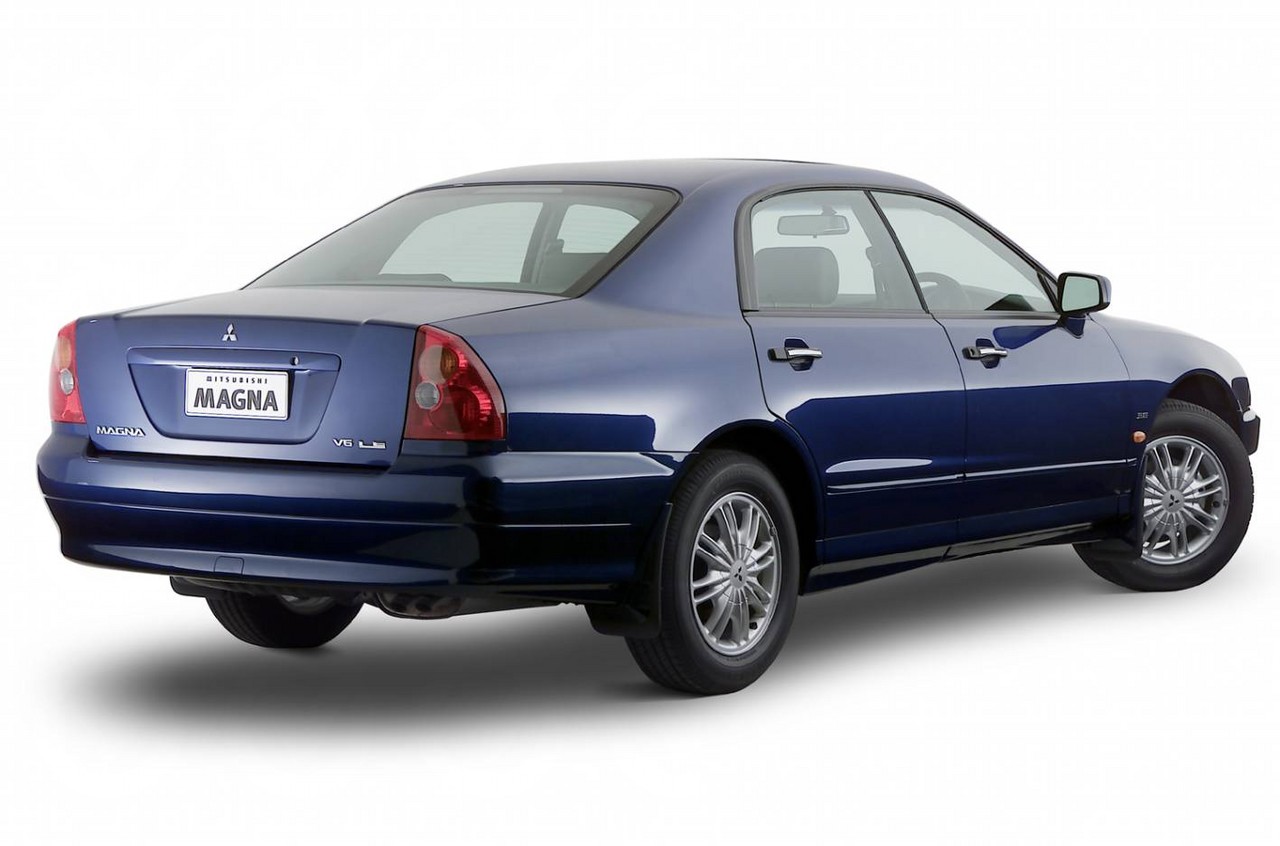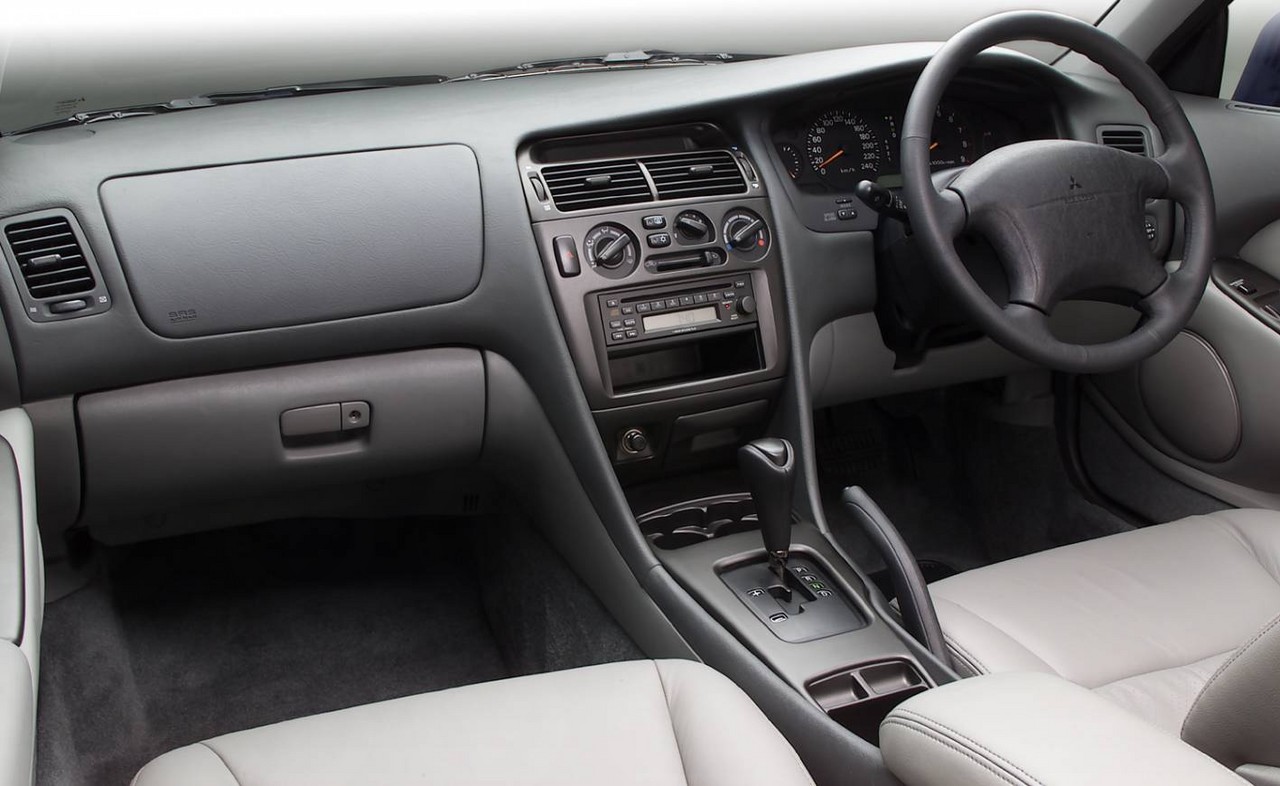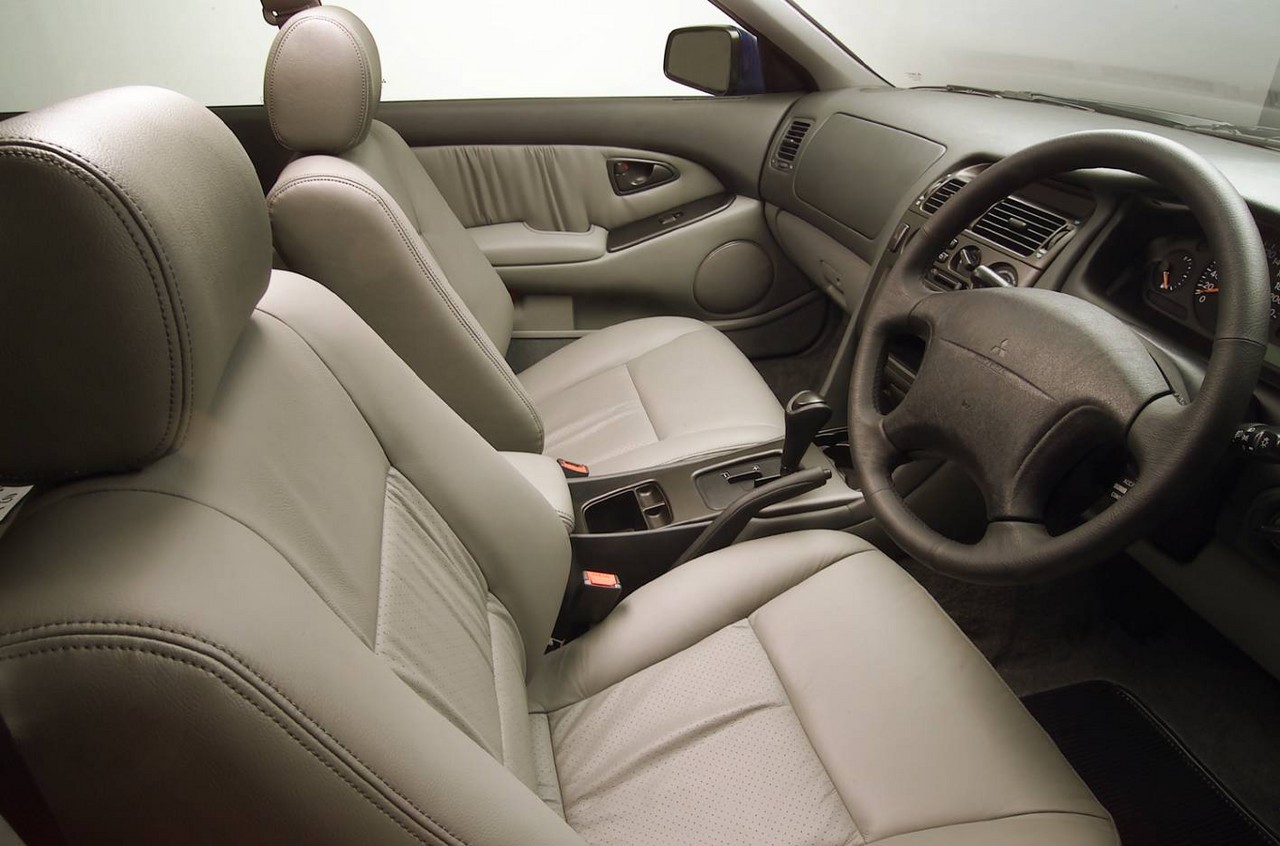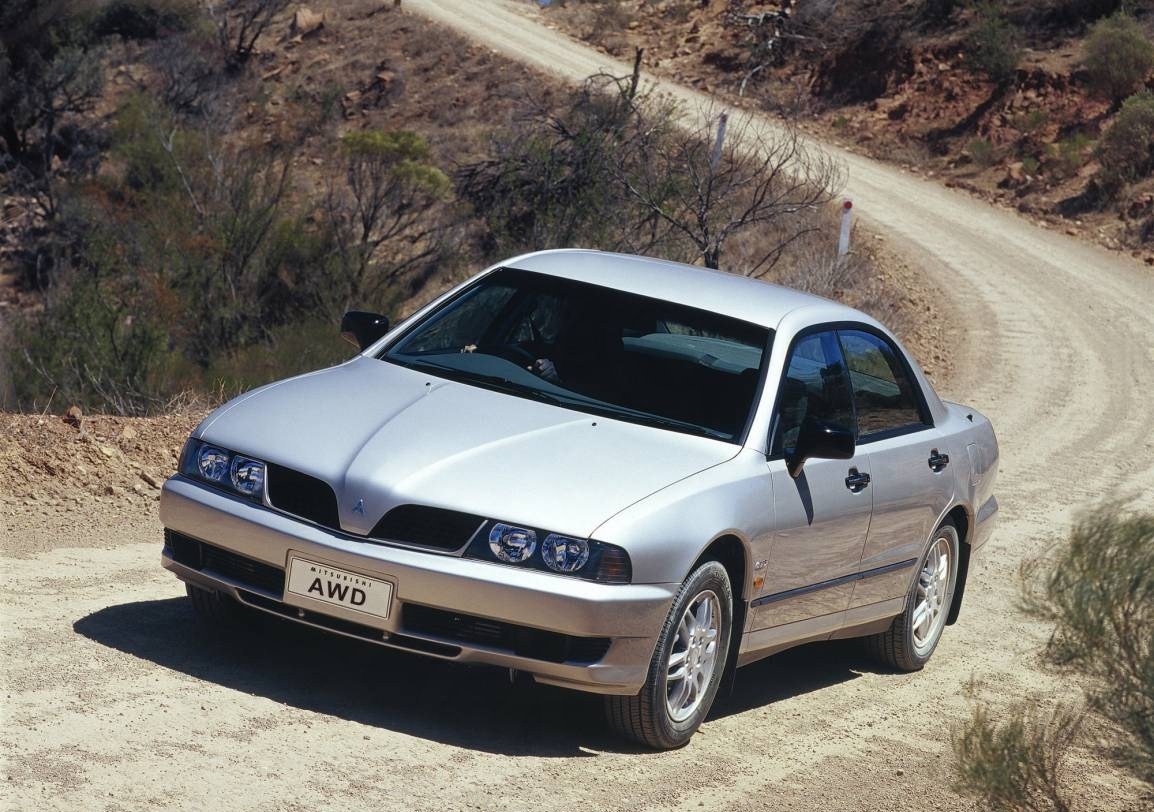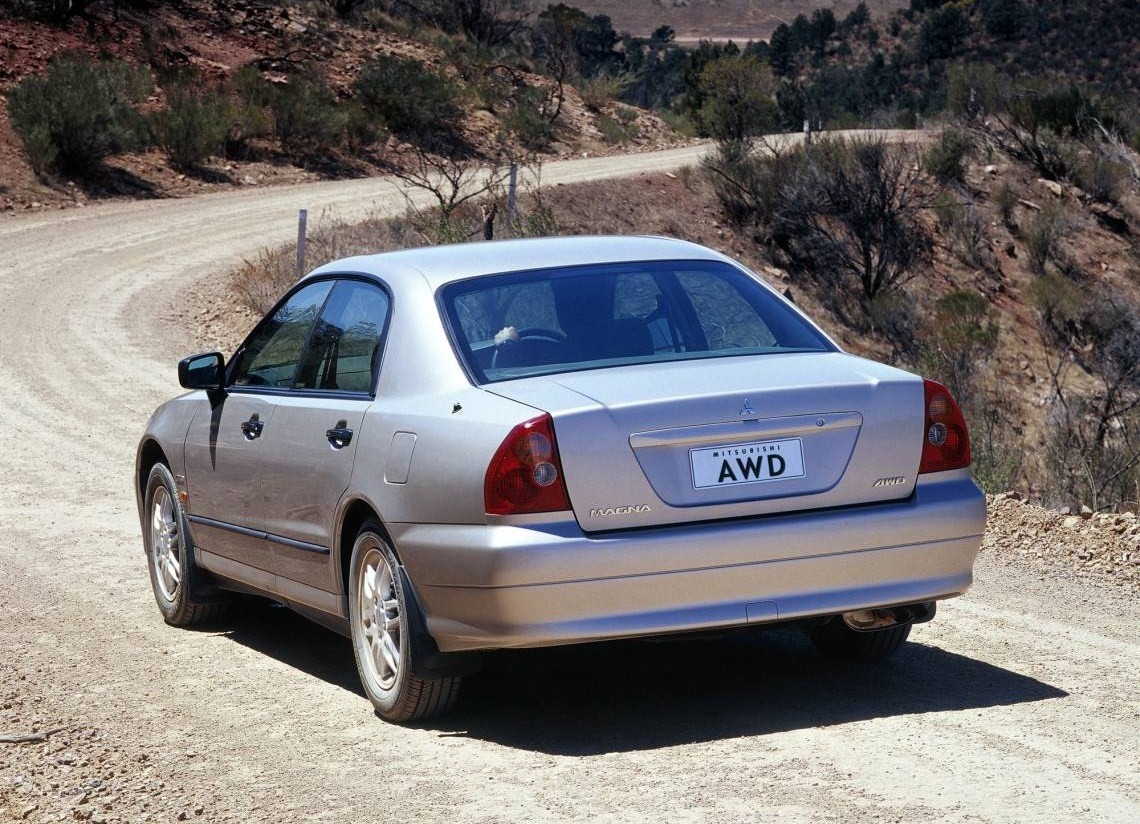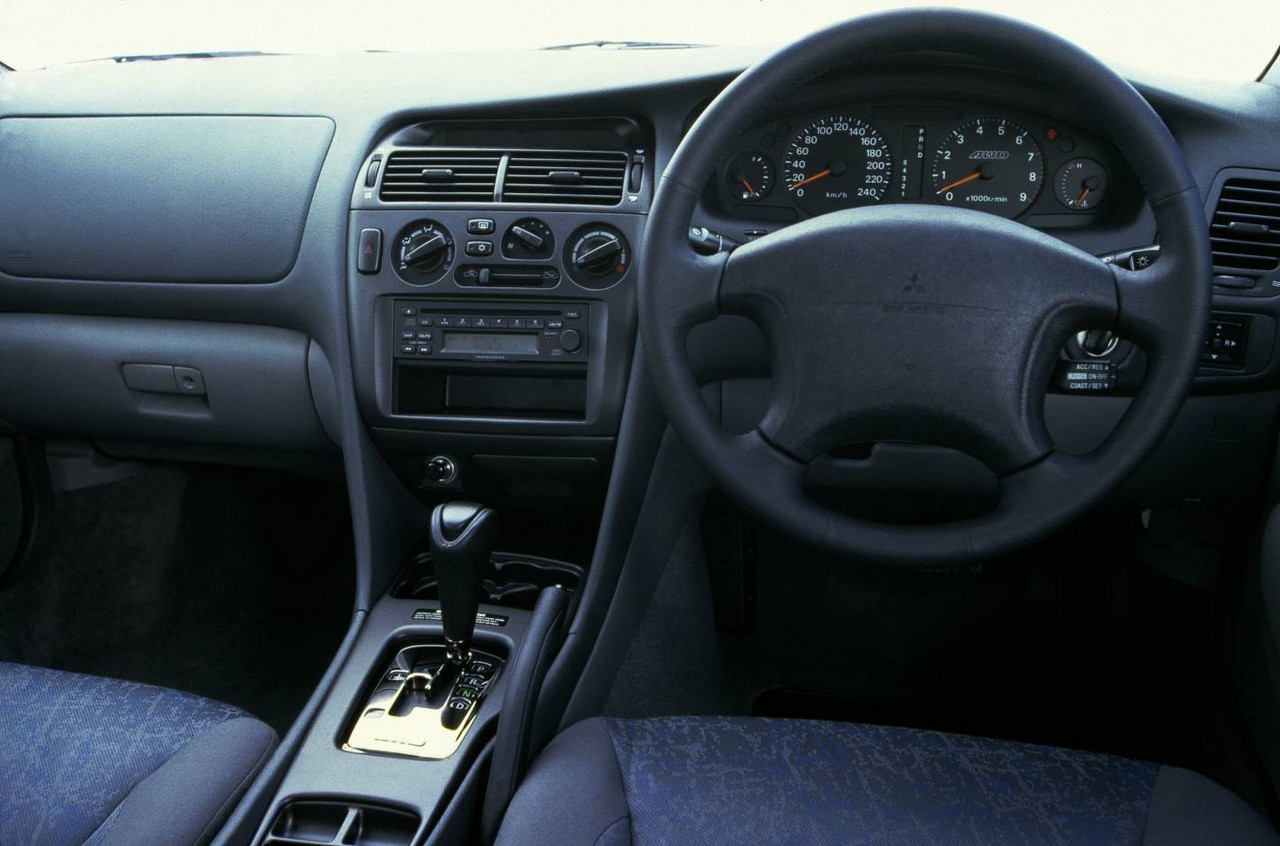
- Responsive and refined 3.5-litre V6 engine
- Intuitive five-speed automatic transmission
- Impressive ride/handling balance
- AWD Magna has engaging dynamics
- Quiet, well-insulated cabin
- Well-weighted, accurate steering
- Limited rear seat space
- Steering wheel lacks reach adjustment
- For AWD Magnas, driveline vibration during acceleration
- Large turning circle
- Loud exhaust note for sports variants
Review: Mitsubishi TJ.I Magna (2000-02)
Overview
Released in August 2000, the Mitsubishi TJ Series I (TJ.I) Magna was available as a sedan or wagon. Manufactured at Clovelly Park, South Australia, the front-wheel drive TJ Magna was powered by either 3.0- or 3.5-litre V6 petrol engines. As per the table below, the TJ.I Magna range consisted of Executive, Advance, Sports and VR-X variants, though there were also limited-run Solara and V6 Si variants (based on the Executive and Advance, respectively).
6G72 and 6G74 engines
Both the 3.0-litre 6G72 and 3.5-litre 6G74 V6 petrol engines had a cast iron block, single overhead camshaft, four valves per cylinder and a compression ratio of 9.0:1. Transmission choices consisted of a five-speed manual or four-speed automatic unit, the latter with ‘Smart Logic’ programming which enabled it to adapt to driving conditions and style.
Dimensions and styling
The TJ Magna sedan was 4808 mm long, 1785 mm wide, 1435 mm tall and had a 2722 mm long wheelbase. Relative to the sedan, wagon bodies were 24 mm longer (at 4832 mm) and 47 mm taller (1482 mm).
Compared to its TH Magna predecessor, the TJ Magna could be identified by its extended bonnet which formed a body-coloured ‘nose’ section for the grille; at the rear, the decklid was redesigned into a one-piece unit and there were new combination lamps. Inside, there were new two-tone colour combinations and upgraded audio units.
Suspension
The TJ Magna sedan had MacPherson strut front suspension with lower A-arms and an anti-roll bar and independent, multi-link rear suspension with upper and lower control arms. The TJ Magna wagon, however, had a tubular rear axle with four trailing arms and a lateral locating rod.
| Body | Engine | Variant | Trans. | Years | Peak power | Peak torque |
|---|---|---|---|---|---|---|
| Sedan | 3.0-litre petrol V6 | Executive | 4sp auto, 5sp man. |
2000-02 | 140 kW at 5500 rpm | 255 Nm at 4500 rpm |
| 3.5-litre petrol V6 | Executive | 4sp auto, 5sp man. |
2000-01 | 150 kW at 5000 rpm | 300 Nm at 4000 rpm | |
| 2001-02 | 155 kW at 5250 rpm | 316 Nm at 4000 rpm | ||||
| Advance | 4sp auto | 2000-01 | 150 kW at 5000 rpm | 300 Nm at 4000 rpm | ||
| 2001-02 | 155 kW at 5250 rpm | 316 Nm at 4000 rpm | ||||
| Sports, VR-X |
5sp auto, 5sp man. |
2000-02 | 163 kW at 5250 rpm | 317 Nm at 4500 rpm | ||
| Wagon | 3.5-litre petrol V6 | Executive, Advance |
4sp auto | 2000-01 | 150 kW at 5000 rpm | 300 Nm at 4000 rpm |
| 2001-02 | 155 kW at 5250 rpm | 316 Nm at 4000 rpm | ||||
| Sports | 5sp auto | 2001-02 | 163 kW at 5250 rpm | 317 Nm at 4500 rpm |
Safety equipment
Standard safety equipment for the Magna Executive included a driver’s airbag, while the Sports added ABS and electronic brake force distribution. The Advance and VR-X were further equipped with a front passenger airbag.
The Magna Sports and VR-X variants – when fitted with automatic transmissions – were also fitted with traction control and Mitsubishi’s ‘Traction Control Logic’. While traction control (Mitsubishi’s ‘Slip Control’ reduced engine power to reduce front wheelspin under acceleration, Trace Control would reduce power if the inputs indicated that the driver was driving too quickly or aggressively through a corner. However, the Trace Control system relied on inputs from steering wheel angle, throttle position and wheel speed rather than lateral or longitudinal sensors.
From September 2001, the Executive was fitted with ABS and electronic brake force distribution; side impact protection was also improved due to the fitment of ‘energy absorbers’ in the front doors.
ANCAP crash testing
In ANCAP crash testing , a TJ.I Magna Executive – equipped with a driver’s airbag and manufactured in August 2001 – received a three star adult occupant protection rating with a score of 17.5. In the offset crash test, the passenger compartment was substantially deformed; there was a risk of serious chest injury for both front occupants and protection from lower leg injury was poor for the driver. In the side impact test, there was a high risk of life-threatening chest injury for the driver.
Features
Standard features for the Magna Executive included a four speaker sound system with CD player and auxiliary input, air conditioning, remote central locking, power mirrors, a tilt adjustable steering wheel, trip computer and an immobiliser. The Magna Advance added cruise control and power windows.
Of the sports models, the Sport variant featured 16” x 7” alloy wheels with 215/60 R16 tyres and a leather-wrapped steering wheel and gearshift. The VR-X was differentiated by its full body kit, consisting of a front air dam, side and rear skirts, wheel arch extensions, rear deck lid spoiler, and a large round chromed exhaust.
May 2001: Magna update
From May 2001, all VR-X variants were fitted with 17” x 7” alloy wheels with 225/50 R17 Bridgestone Grid II tyres. Furthermore, the suspension was also modified with higher rate springs, revised shock absorbers and a new front sway bar. Cosmetically, both the Sports and VR-X were fitted with black brake calipers, black interior door handles and a black insert on the exterior door handles. In addition to their free-flowing exhaust and unique engine calibrations, the Sports and VR-X variants were also available a five-speed ‘Sports Mode’automatic transmission with sequential shift function.
September 2001: Magna update
From September 2001, the Executive variant was fitted with power windows as standard, while the Advance, Sports and VR-X were fitted with a six speaker sound system, climate control air conditioning, front map lamps, glovebox lamp and power antenna. The Sports was also fitted with a rear-deck spoiler. Power for the 3.5-litre V6 engine also increased to 155 kW due to a higher compression ratio and the introduction of a Karman Vortex airflow meter.
2000 Magna Solara
In October 2000, a limited-run Solara variant was released. Based on the Advance, the Solara was distinguished by its 15-inch ‘Manta’style alloy wheels and four-disc in-dash CD player. Visually, the Solara could be identified by its two-tone paint finish and body-coloured exterior mirrors, front grille and door side mouldings.
2001 Magna VR-X Limited Edition
The VR-X Limited Edition was released in May 2001, coinciding with the updates for the Sports and VR-X. The VR-X Limited Edition was distinguished by its eight speaker sound system with four-disc in-dash CD player, red or blue leather-trimmed seats with ‘sports’fabric, colour-matched meter dials, silver-finish centre console and a two-tone leather-wrapped steering wheel.
2001 Magna V6 Si
In September 2001, a limited-run V6 Si variant was released. Based on the Executive sedan, the V6 Si was distinguished by its 16-inch alloy wheels, cruise control and power windows. Visually, the V6 Si could be identified by its rear-deck sports spoiler with high-mounted stop lamp and body-coloured grille, side mouldings, splash protectors, air dam and door mirrors.
2002 Magna Commonwealth Games Edition
In March 2002, a Commonwealth Games Edition variant was released. Solely available as a sedan, the Commonwealth Games Edition was based on the Executive but was further equipped with a front passenger airbag and featured 16-inch alloy wheels, six-disc CD player, cruise control, floor mats and power antenna.Visually, the Commonwealth Games Edition could be identified by its body-coloured grille, side mouldings, splash protectors, air dam and door mirrors.
Review: Mitsubishi TJ.II Magna (2002-03)
Overview
Released in July 2002, the TJ Series II (TJ.II) was a minor update for the Magna range. The ‘Sports Mode’ transmission – with tiptronic-style shifting – was made standard for all automatic models and the Executive and Advance variants had new, grey-only interior trim and body-coloured grille surrounds. In December 2002, the Magna range was expanded with the introduction of the AWD and Sports AWD variants, fitted with Mitsubishi’s QuadTec AWD system. In April 2003, a dedicated LPG Magna Executive was released.
| Body | Engine | Variant | Trans. | Peak power | Peak torque |
|---|---|---|---|---|---|
| Sedan | 3.5-litre LPG V6 | Executive | 4sp auto | 143 kW at 5000 rpm | 296 Nm at 4000 rpm |
| 3.5-litre petrol V6 | Executive | 4sp auto, 5sp man. |
155 kW at 5250 rpm | 316 Nm at 4000 rpm | |
| Advance | 4sp auto | 155 kW at 5250 rpm | 316 Nm at 4000 rpm | ||
| AWD | 5sp auto | 154 kW at 5000 rpm | 310 Nm at 4000 rpm | ||
| Sports AWD | 5sp auto | 159 kW at 5500 rpm | 318 Nm at 4000 rpm | ||
| Sports, VR-X |
5sp auto, 5sp man. |
163 kW at 5200 rpm | 317 Nm at 4500 rpm | ||
| Wagon | 3.5-litre petrol V6 | Executive, Advance |
4sp auto | 155 kW at 5250 rpm | 316 Nm at 4000 rpm |
| Sports | 5sp auto | 163 kW at 5200 rpm | 317 Nm at 4500 rpm |
Safety equipment
Safety equipment for the TJ.II Magnas were unchanged from their TJ.I predecessors. The AWD and Sports AWD variants, however, were fitted with dual front airbags, electronic brake force distribution and more powerful brakes with 294 mmventilated front discs with two-piston calipers and 284 mm ventilated rear discs.
Features
Similarly, standard features for the TJ.II Magnas were unchanged from their TJ.I predecessors.
QuadTec AWD system
Derived from the Japanese AWD Diamante and Lancer Evolution VI, the full-time four-wheel drive system featured an open front differential, a viscous coupling centre differential and a mechanical plate-type limited slip rear differential. The system provided a default 50:50 front/rear torque split, but could transfer torque between the front and rear axles and between the rear wheels in the event that traction was lost. The suspension was also upgraded with a rear stabiliser bar.
Features: Magna AWD and Magna Sports AWD
Compared to the Executive, the AWD featured 16-inch ten-spoke alloy wheels, Bridgestone Turanza 215/60 R16 tyres, dual multi-parabola headlights, front door courtesy lamps, leather-wrapped steering wheel and gearshift, chrome gearshift surround, body-coloured mirrors and side splash protectors. Compared to the Sports, the Sports AWD was fitted with 16-inch seven-spoke alloy wheels with 215/60 R16 Bridgestone Grid II tyres.
2002 Magna Limited Edition
In November 2002, a Limited Edition variant was released. Based on the Executive, the Limited Edition was further equipped wit a passenger airbag and featured 16-inch alloy wheels, leather interior trim (seats and door inserts), cruise control, front fog lamps and a leather-wrapped steering wheel and gearshift. Visually, the Limited Edition was distinguished by its body-coloured mirrors, side protection mouldings and side air dams.
Related links
